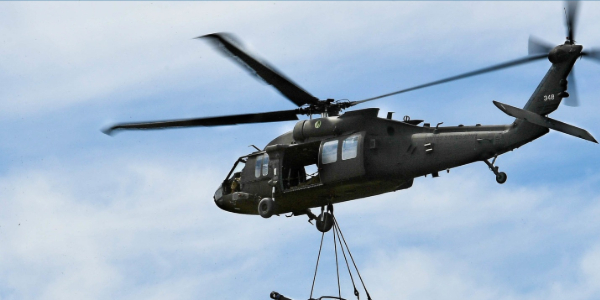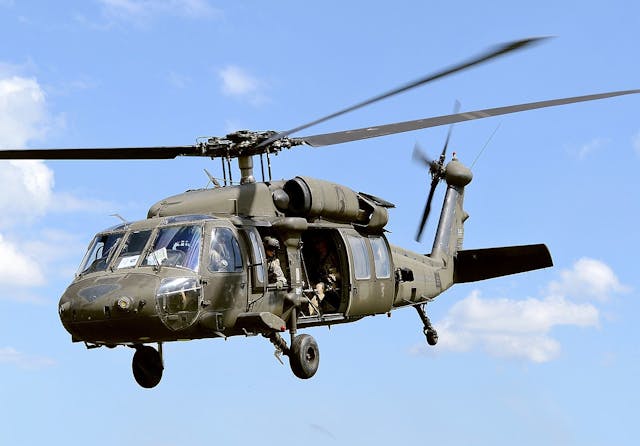Unveiling the Power and Adaptability of the Blackhawk Helicopter
The Blackhawk helicopter stands as a testimony to design quality and armed forces technology, dramatically forming the landscape of modern-day aerial operations. Originally created in the late 1960s, this dual-engine airplane has actually developed right into a diverse platform efficient in executing an array of objectives, from tactical army deployments to immediate medical emptyings. Its style integrates cutting-edge innovation and materials, improving both performance and survivability. As we explore its history and functional abilities, one must think about how the Blackhawk remains to influence contemporary fight approaches and humanitarian initiatives alike. What does this mean for the future of army aeronautics?
History of the Blackhawk
The history of the Blackhawk helicopter is noted by considerable technical advancements and a strategic evolution in armed forces aeronautics. Developed in the late 1960s by Sikorsky Aircraft, the UH-60 Blackhawk was originally conceived to replace the older UH-1 Iroquois, commonly referred to as the "Huey." The Blackhawk's initial trip took place in 1974, and it was formally introduced to the united state Army in 1979.


This airplane was developed to satisfy the requiring needs of modern war, focusing on versatility, speed, and sturdiness (Blackhawk Helicopter). Its capability to operate in different atmospheres, paired with advanced avionics and style features, swiftly established the Blackhawk as an essential possession for army procedures worldwide
Throughout the 1980s and 1990s, the Blackhawk saw considerable use in different disputes, including the Gulf Battle and humanitarian objectives. Today, the Blackhawk stays a legendary icon of military aviation, continually improved to fulfill modern challenges.
Secret Attributes and Requirements
Blackhawk helicopters are renowned for their engineering quality and operational flexibility, flaunting a variety of essential attributes and specifications that improve their efficiency in numerous armed forces functions. Among one of the most significant characteristics is their dual-engine setup, normally powered by the T700-GE-701C engines, which supply exceptional dependability and efficiency. The helicopter has a maximum cruise speed of around 150 knots and a service ceiling of around 20,000 feet, allowing it to run successfully in varied settings.
The Blackhawk's airframe is built from sophisticated composite products and aluminum alloys, ensuring a robust framework while minimizing weight. It features a fully expressed blades system that supplies superior dexterity and security. The helicopter can fit approximately 11 fight soldiers or bring up to 8,000 pounds of outside cargo, making it highly versatile for numerous objectives.
Furthermore, the Blackhawk is geared up with innovative avionics and interaction systems, boosting situational awareness and goal sychronisation. Its ability to run in adverse weather condition conditions, integrated with its low acoustic signature, makes it a sneaky choice for tactical operations. On the whole, these attributes add to the Blackhawk's credibility as a keystone of modern-day military air travel.
Versatile Operational Responsibilities
Distinguished for their engineering quality and progressed abilities, Blackhawk helicopters serve a wide range of operational functions within military frameworks. Originally created for troop transportation, their versatility has actually broadened, enabling them to execute different goals efficiently.
One of the key roles of the Blackhawk is as an utility helicopter, facilitating logistical support by transporting products and workers to and from remote places. In addition, they excel in medical evacuation (MEDEVAC) operations, furnished with innovative clinical tools and workers to give crucial treatment in the area.
In battle situations, Blackhawks can run as armed escort systems, supporting ground forces by involving enemy assets while guaranteeing troop safety. Their ability for special operations makes them crucial; they can conduct reconnaissance directory objectives, workers recuperation, and direct activity raids, frequently in high-threat settings.
In Addition, the Blackhawk's versatility allows it to support altruistic objectives and catastrophe reaction efforts, supplying aid and crucial solutions in times of dilemma. This broad spectrum of functional functions demonstrates the Blackhawk helicopter's unmatched convenience, declaring its condition as a vital asset in modern-day army procedures worldwide.
Technical Developments
Numerous technological technologies add to the Blackhawk helicopter's remarkable efficiency and adaptability in diverse operational atmospheres. One of the most substantial innovations is its composite rotor blades, which boost lift and ability to move while lowering weight and upkeep requirements. The blades system uses innovative materials that bolster sturdiness and resist ecological destruction, guaranteeing reputable procedure in severe conditions.
Furthermore, the Blackhawk is geared up with a cutting edge avionics collection that incorporates innovative navigating and communication systems - Blackhawk Helicopter. This consists of GPS, radar, and multi-function screens that facilitate real-time situational awareness for pilots, adding to mission success under difficult conditions
Additionally, the helicopter's fly-by-wire control system allows for precise handling and enhanced responsiveness, providing pilots with boosted control during complex maneuvers. The consolidation of sophisticated engine technology, such as the T700-GE-701C engine, more improves efficiency, using increased power outcome and gas performance.
Last but not least, modular style principles make it possible for quick reconfiguration for numerous goals, from troop transportation to medical discharge, making the Blackhawk a functional asset in humanitarian and army operations. These technical innovations collectively make certain that the Blackhawk continues to be an awesome presence in the skies.
Influence on Modern Warfare

Outfitted with advanced avionics and interaction systems, the Blackhawk enables smooth coordination among ground and air systems, making certain timely and precise response to dynamic fight situations. Its flexibility allows for fast deployment in varied atmospheres, from city setups to rugged surfaces, mirroring the complex nature of modern war.
In Addition, the Blackhawk's premium speed and agility assist in quick insertion and extraction of employees, decreasing direct exposure to adversary fire. Its capability to operate in aggressive conditions, coupled with sophisticated defensive steps, boosts survivability and objective success prices.
As modern-day problems progressively depend on joint procedures and rapid feedback, the Blackhawk helicopter continues to be at the center of army method, personifying the advancement of air wheelchair and the crucial duty of air power in achieving strategic purposes. Its influence on modern-day war remains to redefine the capabilities of militaries around the world.

Conclusion
Finally, the Blackhawk helicopter exhibits the crossway of sophisticated engineering and functional flexibility, strengthening its standing as a keystone of modern-day armed forces aeronautics. Its historic significance, remarkable features, and versatility throughout various objective profiles underscore its important duty in contemporary warfare. As technological innovations remain to enhance its capabilities, the Blackhawk continues to be an essential property for militaries globally, showing unequaled effectiveness in both battle and altruistic operations.
The Blackhawk helicopter stands as a testament to design excellence and armed forces technology, dramatically shaping the landscape of contemporary aerial operations.The history of the Blackhawk helicopter is noted by substantial technological advancements and a critical development in armed forces aviation.Blackhawk helicopters are renowned for their engineering quality and operational flexibility, flaunting a range of essential attributes and specs that boost their effectiveness in different army duties.Various technological innovations contribute to the Blackhawk helicopter's extraordinary efficiency and adaptability in varied operational settings.In conclusion, the Blackhawk helicopter exemplifies the intersection of advanced engineering and operational flexibility, solidifying its standing as a cornerstone of modern military aeronautics.